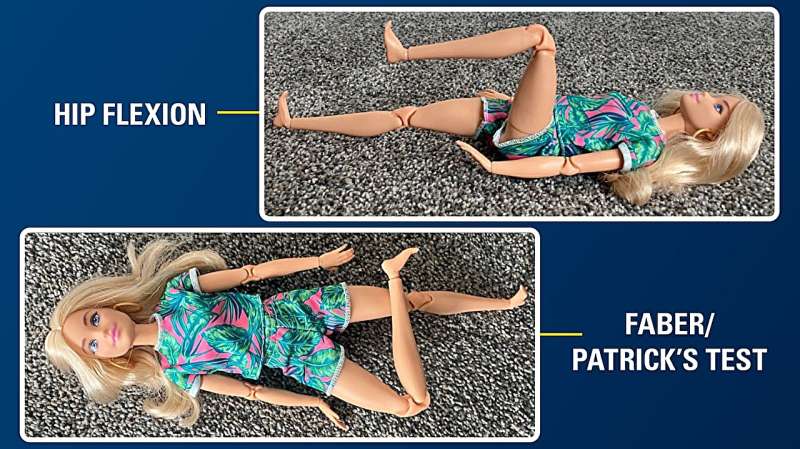This article has been reviewed according to Science X's editorial process and policies. Editors have highlighted the following attributes while ensuring the content's credibility:
fact-checked
trusted source
proofread
Barbie may help physicians, patients have more productive telehealth visits

As telehealth visits become more prevalent, physicians can sometimes struggle to help patients effectively demonstrate a musculoskeletal exam through a screen.
At the University of Michigan Health C.S. Mott Children's Hospital, one physician found a way to help pediatric patients demonstrate different joint movements using a Barbie doll.
While on telehealth appointments with patients, Alecia Daunter, M.D., an assistant professor of pediatric rehabilitation medicine at U-M Health, found that verbally explaining how she wanted her patients to move their bodies was often challenging, sometimes leading to poorer quality visits and frustration. To try something new, she grabbed a Barbie doll off her desk and began to demonstrate what she wanted to see from the patient on the doll.
The findings were published in PM&R: The journal of injury, function and rehabilitation.
"The Barbie I use comes with a wheelchair and can bend at almost all of her joints. She's an ideal model to help show my patients how I need them to move, flex, or extend their joints," said Daunter.
"As I found this increasingly helpful with my own patients, some of my colleagues suggested that I should study this method to share it with other physicians."
Virtual world
Daunter and her lead co-author Alyssa Cook, M.D., a physical medicine and rehabilitation resident at U-M Health, had two groups of children between the ages of four and 17 years old—totaling 30 children and their parents—participate in the research via Zoom meetings.
Cook used a prewritten script to take the control group children and parents through a series of physical exam maneuvers without the Barbie doll. The second group heard the same script while Cook used the Barbie doll to demonstrate the movements that the physicians wanted to see.
Afterward, Daunter and co-author Britney Papp, D.O., a former pediatric physical medicine and rehabilitation fellow at U-M Health, analyzed each video to determine the time to complete the entire examination, ensure each maneuver was completed correctly, and count the number of times participants needed verbal corrections to complete each step.
"Without the Barbie doll, the patients, parents, and I sometimes became frustrated when it was difficult to understand what should be demonstrated, although we always finished the session," said Cook.
"When the Barbie doll was used, the patients had a better understanding of what they needed to demonstrate, and I found it easier to explain what we were looking for. This is something I have also found true in my daily clinical practice."
In a survey given to participants after the video call was conducted, all participants from the group with the Barbie doll felt that their experience was enhanced, and it was easier to understand what the physician was looking for.
For the physicians, the Barbie doll didn't make the appointment shorter but also didn't add any time to the appointment. The participants who had the benefit of the Barbie doll required less verbal prompting to complete the examination successfully.
Not just Barbie
Cook and Daunter encourage other health care professionals to use some form of visual aid when asking patients of any age to demonstrate movement during a virtual appointment.
"It doesn't necessarily have to be a Barbie doll. Other action figures or small wooden artist mannequins will have the same effect. You just need to make sure the doll has joints that can move in a way that demonstrates what is being examined," said Daunter.
"As telehealth becomes more prevalent, we need to adapt to make sure our patients are still receiving quality care and are at ease during their appointments."
More information: Alyssa K. Cook et al, Visual aid for pediatric virtual musculoskeletal exams: A Barbie girl in a telehealth world, PM&R (2024). DOI: 10.1002/pmrj.13167


















